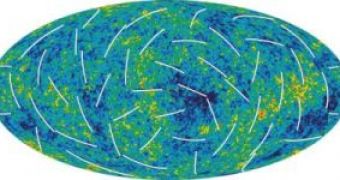About 13.7 billion years ago, the Big Bang marked the beginning of our Universe. Since then, it has been expanding. The most natural thing to assume is that this expansion happens at the same rate in all directions and thus the Universe as a whole is a sphere.
However, Leonardo Campanelli of the University of Ferrara and his colleagues Paolo Cea and Luigi Tedesco at the University of Bari (all in Italy) have now reexamined the data taken by the Wilkinson Microwave Anisotropy Probe (WMAP) and have concluded that the observed Universe looks like an ellipsoid, rather than a sphere.
The WMAP has monitored the microwave radiation that is though to be a leftover from the early Universe. At first, when things like protons, neutrons, electrons and photons had formed the photons (the particles of light) could not travel to much without being scattered by some electrons - the Universe was opaque. But when it expanded and it had cooled sufficiently the electrons were captured by protons and the first atoms appeared. From that moment on light could travel on longer distances and the Universe had become transparent. The microwave background radiation is the light that has remained since then.
Studying this microwave residue scientists managed to determine things like the age of the Universe, the time when the first atoms formed (380,000 years after the big bang), and the fractions of all available energy vested in the form of ordinary matter, dark matter, and dark energy. (Read article.)
But the WMAP has also revealed one odd fact: When studying this radiation on the largest scales, covering the entire sky, there aren't equal amounts of energy coming from all directions. It is as if at the moment when the Universe had become transparent it wasn't spherical but an ellipsoid. Presumably, it has grown to the same shape ever since - the original ellipsoid might have become even more accentuated.
This isn't the first time somebody suggests the Universe is an ellipsoid, but it is the first time the claim seems to have an empiric basis. Others have argued that the Universe might not be spherical thinking of an analogy with the transition from the Copernican system (that assumed the planets rotate around the Sun on circles) to the Kepler-Newton system (who showed that and why they are actually following ellipses). The transition from the spherical Universe to the ellipsoid one might seem a nice parallel.
But insofar nobody really knows why such a thing could happen. Campanelli, Cea and Tedesco speculate that maybe the departure from the perfect sphere is due to a uniform magnetic field pervading the entire cosmos. Such a magnetic field might be produced by the motion of the charged particles that make up the cosmic plasma - in the same way as there still is light from the beginning of the Universe there also might be some protons and electrons that haven't (yet) combined into atoms. Another wild idea put forward by the researchers is that the eccentricity of this ellipsoid Universe might be caused by some "defect" in the fabric of space-time.

 14 DAY TRIAL //
14 DAY TRIAL //